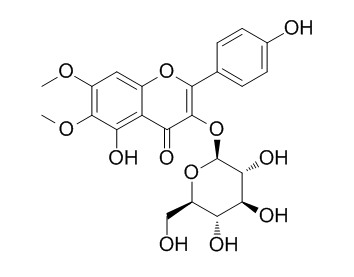Eupalitin 3-galactoside
Eupalitin-3-O-β-D-galactoside(Eupalitin 3-galactoside) has anti-inflammatory effects, it in Conconavalin-A induced koi carp possibly through inhibition of NFkB and p38 MAPK that mediates the expression of pro inflammatory cytokine TNF-α.
Inquire / Order:
manager@chemfaces.com
Technical Inquiries:
service@chemfaces.com
Tel:
+86-27-84237783
Fax:
+86-27-84254680
Address:
1 Building, No. 83, CheCheng Rd., Wuhan Economic and Technological Development Zone, Wuhan, Hubei 430056, PRC
Providing storage is as stated on the product vial and the vial is kept tightly sealed, the product can be stored for up to
24 months(2-8C).
Wherever possible, you should prepare and use solutions on the same day. However, if you need to make up stock solutions in advance, we recommend that you store the solution as aliquots in tightly sealed vials at -20C. Generally, these will be useable for up to two weeks. Before use, and prior to opening the vial we recommend that you allow your product to equilibrate to room temperature for at least 1 hour.
Need more advice on solubility, usage and handling? Please email to: service@chemfaces.com
The packaging of the product may have turned upside down during transportation, resulting in the natural compounds adhering to the neck or cap of the vial. take the vial out of its packaging and gently shake to let the compounds fall to the bottom of the vial. for liquid products, centrifuge at 200-500 RPM to gather the liquid at the bottom of the vial. try to avoid loss or contamination during handling.
Acta Physiologiae Plantarum2016, 38:7
Microbiol. Biotechnol. Lett.2022, 50(2): 193-201.
Horticulturae2020, 6(4),76.
Front Endocrinol (Lausanne).2020, 11:568436.
Journal of Ginseng Research2019, 10.1016
Mol Cell.2017, 68(4):673-685
Int J Mol Sci.2019, 20(11):E2734
J of Pharmaceutical Analysis2020, doi: 10.1016
Dental Journal2024, 57(4): 254-258
Food Res Int.2024, 197(Pt 1):115244.
Related and Featured Products
Phytochemical Analysis, 2005, 16(6):451-458.
Characterisation of the phenolic profile of Boerhaavia diffusa L. by HPLC-PAD-MS/MS as a tool for quality control.[Reference:
WebLink]
METHODS AND RESULTS:
Phenolic acids and flavonols of nine leaf and three root samples of Boerhaavia diffusa L., collected at different locations and subjected to several drying procedures, were characterised by reversed-phase HPLC-PAD-ESI/MS for the first time. Ten phenolic compounds were identified: 3,4-dihydroxy-5-methoxycinnamoyl-rhamnoside, quercetin 3-O-rhamnosyl(1-->6)galactoside (quercetin 3-O-robinobioside), quercetin 3-O-(2"-rhamnosyl)-robinobioside, kaempferol 3-O-(2"-rhamnosyl)-robinobioside, 3,5,4'-trihydroxy-6,7-dimethoxyflavone 3-O-galactosyl(1-->2)glucoside [eupalitin 3-O-galactosyl(1-->2)glucoside], caffeoyltartaric acid, kaempferol 3-O-robinobioside, eupalitin 3-O-galactoside(Eupalitin 3-galactoside), quercetin and kaempferol. Quantification was achieved by HPLC-PAD and two phenolic patterns were found for the leaves, in which quercetin 3-O-robinobioside or quercetin 3-O-(2"-rhamnosyl)-robinobioside was the major compound. Caffeoyltartaric acid was only present in the root material where it represented the main phenolic constituent.
CONCLUSIONS:
The results obtained demonstrated that the geographical origin (particularly the nature of the soil), but not the drying process, influences the phenolic composition.



